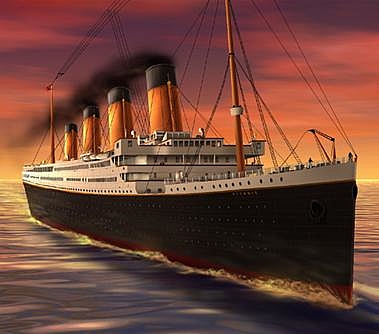
Next Wednesday, April 14, will be the 100th anniversary of one of the world’s most spectacular and heart-wrenching tragedies; 100 years to the very day, since the great passenger ship, the Titanic, struck an iceberg, and sank in the Atlantic Ocean south of the island of Newfoundland, with a massive loss of human life. This week here in Wavescan, and next week also, we memorialize this tragic event, particularly from a radio, or wireless point of view.
Let me read to you these several items of interest taken from an early publication, and we suggest that you listen carefully before you make a judgment:
She was the largest craft afloat and the greatest of the works of men. In her construction and maintenance were involved every science, profession and trade known to civilization.
Two brass bands, two orchestras, and a theatrical company entertained the passengers during waking hours; a corps of physicians attended to the temporal, and a corps of chaplains to the spiritual welfare of all on board.
From the bridge, engine-room, and a dozen places on her deck the ninety-two doors of nineteen water-tight compartments could be closed in half a minute by turning a lever. These doors would also close automatically in the presence of water. With nine compartments flooded the ship would still float, and so no known accident of the sea could possibly fill this many, (and thus) the great steamship was considered practically unsinkable.
Built of steel throughout, she was eight hundred feet long, of seventy thousand tons displacement, seventy-five thousand horse-power, and on her trial trip had steamed at a rate of twenty-five knots an hour.
Unsinkable - indestructible, she carried as few life boats as would satisfy the laws.
“Ice,” yelled the lookout; “ice ahead. Iceberg.”
Seventy-five thousand tons - dead-weight - rushing through the fog at the rate of fifty feet a second, had hurled its elf at an iceberg.
And so the story continues, with a huge loss of life during that notable April evening, with the
ship sinking quite quickly around midnight in the cold waters of the North Atlantic. It was her first, her maiden voyage, across that vast ocean separating Europe from North America. It sounds like the sinking of the Titanic, doesn’t it?
But no, that is not the case. The readings we just presented to you were taken from a novel, written by the American author, Morgan Robertson, in the year 1898, 14 years before the sinking of the Titanic in 1912. The name of the ship in Robertson’s novel, believe it or not, was “Titan”, almost the same name as the “Titanic” 14 years later. Robertson’s novel was named “The Wreck of the Titan”.
There is a strange coincidence linking the names of three different ships, each crossing the Atlantic, and each running into trouble in a massive field of icebergs in the North Atlantic during the month of April. You have just heard the story of the first ship, the fictitious “Titan” in the year 1898, at the time when the young Marconi was just developing his experimental wireless equipment.
The second ship in this triad of troubled ships with a similar name is the “Titanic”, which ran into the field of icebergs just before midnight exactly one hundred years ago, on Sunday April 14, and sank shortly after midnight, in the early hours of Monday April 15. This ship, the “Titanic” was carrying wireless equipment which was pressed into service in calling other ships to the rescue. We will present the details of that story here in Wavescan next week.
The third ship in this triad of troubled ships with a similar name was the “Titanian”, a cargo vessel traveling across the North Atlantic 23 years later, in April 1935. She was carrying coal from Newcastle in England for delivery in Canada.
The story about this ship, the “Titanian” has been embellished a little over the years, but the fact is that she was caught in the iceberg field and stalled, some distance out from Newfoundland. With the stearing gear damaged, she radioed ahead for assistance, and the tug boat “Imogene” was sent to the rescue.
All three ships had a similar name, “Titan”, “Titanic” & “Titanian”; and all three were damaged in collisions with icebergs in the North Atlantic; and all three during the month of April. The fictitious story of the “Titan” was during the era when wireless was under experimental development; the “Titanic” carried wireless equipment that was pressed into usage for the occasion; the “Titanian” used its radio equipment in calling for a tug to render assistance.
Quite remarkable. And like we said earlier, the story of the “Titanic” itself will be featured here in Wavescan next week.
(Wavescan via Adrian Peterson/NWS163)